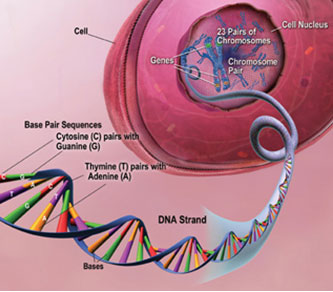
The double helix represents the DNA pattern of human traits.
Source: www.forbes.com
Nearly two decades ago, the general public found the term DNA to be unfamiliar in their lives. Only a few communities were exposed to this term and knowledgeable about it. However, a high-profile court case in the late 1990s made this term popular among the public.
A Brief Look at DNA
DNA, or deoxyribonucleic acid, is a fundamental component of life. It contains biological instructions that shape individual traits. This information is passed down from one generation to another through the process of reproduction (National Institute of Health, 2013).
Every living organism on Earth has a unique DNA pattern, distinguishing a human from a tiger, for example. The DNA of a human, rabbit, or even a tree is inherited from its parents, known as the progenitors.
A human has a complete set of DNA chromosomes obtained from the combination of genes from both the mother and father. This results in a total of 23 pairs of chromosomes, with each pair originating from the mother and father, making a total of 46 chromosomes (American Prosecutors Research Institute, 2003).
These sets of chromosomes carry millions of pieces of information about one’s life as a human. These pieces of information are known as genes, such as eye colour or nose shape (American Prosecutors Research Institute, 2003).
Where is DNA Located in the Body?
When discussing DNA, do you know where it is located in our bodies?
DNA can be found in the nucleus. The nucleus is located within cells that form tissues and subsequently the organs of the body. Apart from the cell nucleus, DNA can also be found in mitochondria.
Which cell types have DNA strands?
DNA can be found in the following cells:
- White blood cell
- Sperm and vaginal secretions
- Mucus, sweat, and saliva
- Hair roots
- Bones
- Teeth
It can also be obtained from organs such as the heart and liver, muscle tissue, and skin.
In usual circumstances, DNA is extracted from the nucleus and tested to obtain its sequence as comparative data. However, in cases such as decomposed bodies or dead cells, mitochondrial DNA is more suitable for analysis compared to nuclear DNA.

The connection between cells and the nucleus in the human body.
Source: http://ocw.mit.edu/
Applications of DNA in Forensic Science
After humans successfully unravelled the mystery of DNA’s chromosome arrangement and its uniqueness as a characteristic of life, it has been applied in forensic investigations. Most cases that utilize DNA profiling are to ascertain the identity of individuals, whether in cases of unidentified bodies, mass disaster fatalities or to identify the biological parents of an abandoned child. It is also useful in resolving issues related to inheritance disputes, paternity and identifying the real father of a child born out of wedlock.
Paternity and Maternity Testing
Currently, the media frequently reports incidents of baby dumping. Babies born out of wedlock are abandoned as if they were trash. If the baby is lucky, they might be rescued by kind-hearted individuals passing by. However, if not, the baby will be left to die without food and water, risking becoming prey for animals.
To find the cruel parents responsible, a comparison of DNA profiles must be conducted. DNA samples need to be taken from the unfortunate baby to obtain their DNA profile. It will then be compared to the DNA profiles of a woman and man suspected to be the biological parents.
The principle is simple. An individual’s set of chromosomes is inherited from their parents. If the DNA profile of the baby matches the DNA samples from the woman and man in question, the baby is likely their child. Further investigation will be conducted by the police to obtain confessions and other supporting evidence.

Quotation from the newspaper about baby dumping.
Source: http://www.teratakarmo.com/2010/04/kes-buang-bayi-berleluasa.html
Investigating Bones or Human Remains
Similar to other cases, the DNA profile from bones found at a crime scene needs to be obtained for reference. A challenge that may arise is the absence of a profile for comparison.
In such situations, if the bones are suspected to belong to a known individual, DNA samples can be obtained from their personal belongings. DNA can be extracted from their toothbrush or a strand of hair found at their home. This DNA profile can then be used for comparison.
Mass Disaster Victims
In situations similar to the above, obtaining a DNA match is essential to confirm the identities of the victims. However, another issue can arise in mass disaster situations.
In cases of mass disasters such as major floods, tsunamis, or earthquakes, the bodies of the victims are difficult to retrieve from the disaster site immediately. It takes time due to various factors such as safety concerns, location suitability, and equipment used, among others.
As a result, the bodies of the victims may decompose before they can be recovered for further action. If the body remains intact, the identification process is relatively straightforward. However, if body parts are severed and mixed up in a large disaster area, it can create challenges.
One of the challenges is determining whether a bone or body part belongs to a male or female. In such cases, DNA analysis becomes crucial to help investigators identify the victims based on small samples found.
How Does DNA Help in Investigations?
Apart from identifying the likelihood of a suspect’s or accused person’s DNA matching that found at the crime scene or on the victim, DNA analysis can help answer other questions. Questions such as “Where was the DNA sample found” and “What type of DNA sample was found” can assist investigators in linking suspects to victims (American Prosecutors Research Institute, 2003).
For example:
- A woman claims she was raped in a car owned by a suspect. The woman’s DNA evidence is found on the car seat along with the suspect’s DNA sample. This links the woman to the suspect in the car, supporting her statement.
- A suspect’s DNA sample is found in the vagina of the victim. It indicates a sexual encounter between the two.
If the victim’s statement mentions scratching the suspect’s face, finding the suspect’s DNA sample on the victim’s fingernails can corroborate her statement.
References
- American Prosecutors Research Institute. (2003, 11). forensic dna fundamentals. Retrieved 06 22, 2013, from http://www.ndaa.org: http://www.ndaa.org/pdf/forensic_dna_fundamentals.pdf
- Butler, J. M. (2008, 08 21). Forensic DNA Testing: How Are Crimes Solved with DNA Analysis? Retrieved 07 08, 2013, from http://maxwellinstitute.byu.edu/: http://maxwellinstitute.byu.edu/files/Forensic-DNA-Testing.pdf
- Lister Hill National Center for Biomedical Communications et al. (2013, 06 17). Genetic Home Reference. Retrieved 06 21, 2013, from http://ghr.nlm.nih.gov: http://ghr.nlm.nih.gov/handbook/basics.pdf
- National Institute of Health. (2013, 06 13). National Human Genome Research Institute. Retrieved 06 21, 2013, from http://www.genome.gov: http://www.genome.gov/25520880
- Petherick. (2010). Forensic Science Central. Retrieved 07 08, 2013, from http://forensicsciencecentral.co.uk/edmondlocard.shtml
- Wellcome Trust. (n.d.). The Human Genome. Retrieved 07 08, 2013, from http://genome.wellcome.ac.uk/: http://genome.wellcome.ac.uk/doc_wtd020877.html
| Last Reviewed | : | February 2024 |
| Writer | : | ChM. Dr. Khairul Adli bin Nikman |







